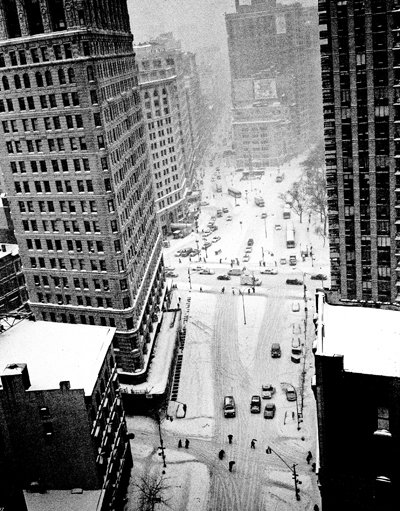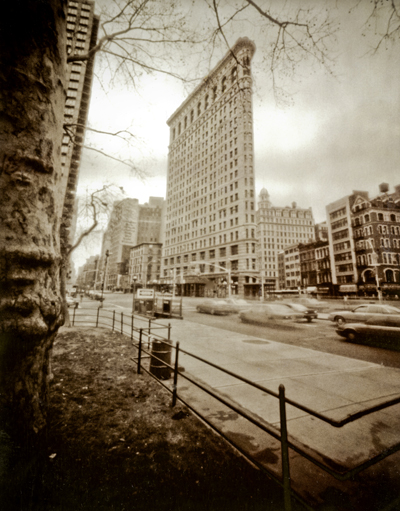Memories of Manhattan
“When we speak about architecture, we refer to significant buildings that frame diverse cultural situations and enable their inhabitants to participate in the order of things. This ability is, of course, another definition of the poetic, the confluence of truth and beauty… Cultural boundaries cannot be reduced simply to geography, nationality, ethnicity, or gender. I contend that our best bet to understand this problem is to consider architectural diversity in relation to fluid linguistic differences, embracing the call for a critical rethinking of the categories of politics.”
Alberto Pérez-Gómez. Built upon Love: Architectural Longing after Ethics and Aesthetics.
I used to perambulate in this city made for walking and observing, unequaled by any other in the world. Treading in this optical machine, in endless exhilaration, under constant threat and with mounting expectation, I stored my experience as accurate mental snapshots. The extreme alienation of objects carried the potential of the body’s recollection of being! I was persistently excluded from participation and continually raped. My sense of individual power and freedom was always challenged by groans, sighs, muffled screams, steps climbing up an iron staircase or resonating in the ill-smelling tunnel, a pane of shattering glass, an iron latch creaking, and heavy footsteps coming closer down the corridor toward my room, while I hid my face in the sheets.
The exciting mental images had never been so clear, the most sophisticated products of perspective; plates that turned sunlight, and particularly electric light, into metaphysical silence. A truly random gathering: the steerage of a ship before dumping its human cargo at Ellis Island; beneath a dirigible the immense erection of lower Manhattan, towers of hope incessantly striving to grow taller, disregarding the simulated end of human ambition enshrined in the World Trade Center twin parallelepipeds; an Italian immigrant woman carrying her home’s materials on the head, in front of an empty lot, strewn with discarded objects like a big brass double bed with its metal springs spilling out tufts of rotten horsehair, a white Buick, recent model, with no engine or wheels, and a three-story iron fire stair, placed within the lot in the guise of a pulpit; six young newsies with vivid eyes, holding their quota of papers under their arms and dreaming of utopia on the Brooklyn Bridge; an early type of playground for tenement children below clotheslines; a baby pleasantly sleeping on the sidewalk, beneath a poster advertising a performance of La Traviata in honor of Sig. Carlo Tricoli, starring Renata Brunorini diva extraordinaire as Violeta; a frozen cadaver on the pavement, under a cover of old posters and newspaper, in the process of being tagged by a policewoman; the hand of man in railway and subway tunnels, and beyond, the dangerous platforms; a long corridor, always very dirty, hollow, and silent, marked by disgusting damp stains and colorful new posters, leading to a huge, similarly vacant area, either dimly lit or brilliantly illuminated by harsh many-colored bulbs; a nun, her fingers barely touching her lips, awaiting survivors from a disaster at sea; the heavy, circular brushed stainless steel vault door, Mosler brand, perfectly accessible to my eyes behind a large glass pane on Fifth Avenue; railroad trains on the bridge, somber like coffins, unending noise of silence; white satin dresses tightly held at the waist by clasped male hands, dancing; the same nun in a hurry with her veil trailing in the wind, pushing a baby pram in front of a brownstone Ionic porch at the bottom of the picture; a wife comforting her husband just arrested for killing a member of her family; several rooms with a view, domestic and intimate scenes framed by indiscreet windows, always open to the city, the edge condition brightly lit; a pig and a blonde in a low-cut satin dress sharing a table in Sammy’s at the Bowery;
Marilyn Monroe in the act of contracting her lips and half-closing her eyes to blow a kiss into space; the roofs of Washington Square, presence of space between chimneys, water towers, and demolished fire towers; a man in white carrying four small wooden female mannequins, some without limbs; a man with a black jacket and a hat, smoking a cigarette without using his hands; the inside of an ornamented movie theater, the film being shown almost totally out of the picture while a brighter electric light reveals the absent meditation of a uniformed woman usher standing by the emergency exit; many gigantic hotels, ideal cities for permanent transients and entertainment parks for serious adult play, all ephemeral; the reflections of multiple lines of bare bulbs on the windows of the subway train; a number of people reading Listen to God and turning their gaze upward as they cross the street; the elephantine colossus in West Brighton Beach, Coney Island, which cost over a quarter of a million dollars, acme of architectural triumphs containing a whole summer resort in one enormous structure; a young Brooklyn family going for a Sunday outing; more young people in a scattered crowd of regular density, in groups of two or three boys, although after close scrutiny, under the short hair, tight blue jeans, turtleneck sweaters, and leather or denim jackets, there are incontestable girls’ bodies, eating hot dogs or adopting poses intended to express self-confidence; a child in Central Park playing with a toy grenade in one hand and making a more threatening gesture with the left hand; a very low-key black and white photograph of a castle in Disneyland, California, the albescent swan too visible behind a pane of glass. as usual accessible only to my gaze; two adolescents in a Yonkers dance hall, posing beside a trophy proclaiming them the Junior Interstate Ballroom Dance Champions; a backward man in his hotel room, his nose pointing opposite to his feet; a Jewish giant with his parents in the living room of their home in the Bronx; the star-spangled banner extended during a patriotic holiday behind the ample glass window of a grocery shop, freedom within reach of my sight; a young woman executive dressed like a man, entering an office building with other colleagues through the revolving doors; a transvestite draped in green and wearing a winter bonnet, dramatically giving birth to a doll in the middle of the street, surrounded by admiring spectators, mostly smiling children.![]()



